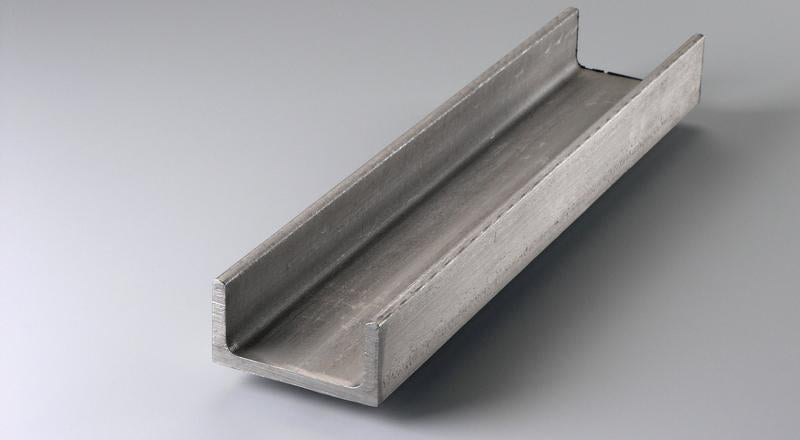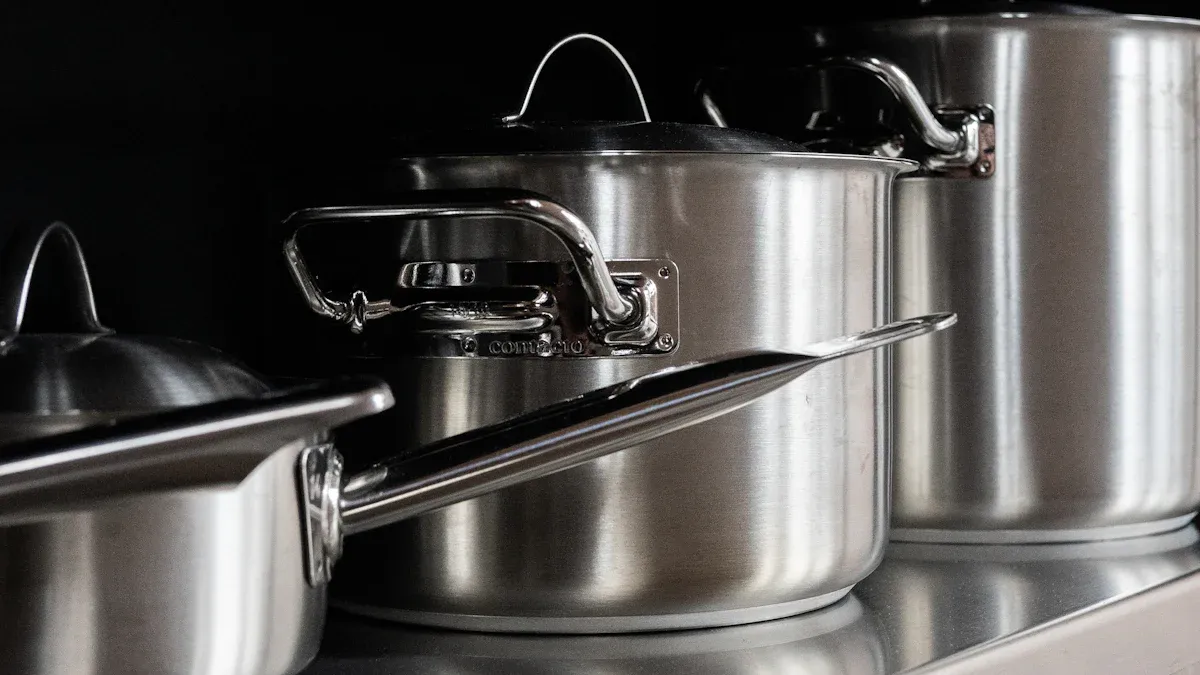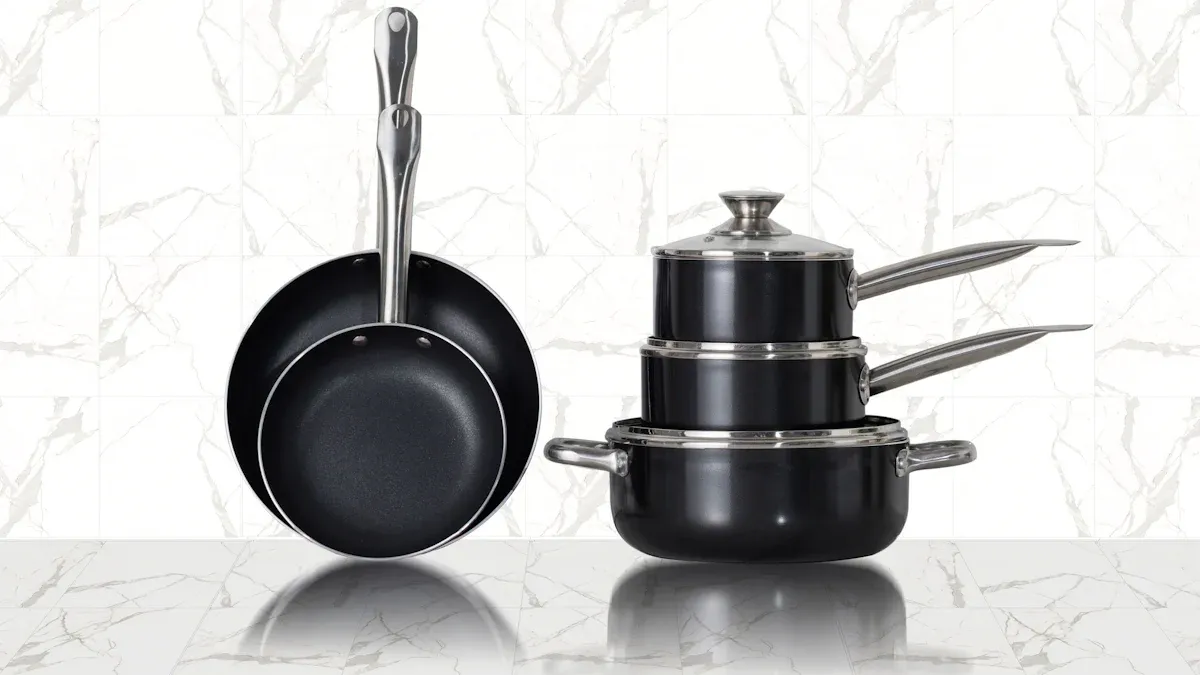
What is 18/10 Stainless Steel and Its Composition
Share
Table Of Content
Table Of Content

18/10 stainless steel is a premium-grade metal alloy made with 18% chromium and 10% nickel. The chromium content provides excellent rust resistance, while the nickel enhances its durability and gives it a polished, shiny appearance. Known for its long-lasting quality and attractive finish, 18/10 stainless steel is an ideal choice for cookware, utensils, and other kitchen tools. Its ability to resist rust and maintain its shine makes it both practical and stylish for everyday cooking and dining needs.
Key Takeaways
- 18/10 stainless steel has 18% chromium and 10% nickel. It resists rust and corrosion very well.
- This steel is safe for cooking acidic foods. It keeps flavors pure without tasting metallic.
- 18/10 stainless steel is strong and lasts a long time. It saves money on replacements and reduces waste.
- Its shiny look makes kitchens prettier, perfect for homes or restaurants.
- Pick 18/10 stainless steel for cookware and utensils. It offers strength, style, and easy cleaning.
What is 18/10 Stainless Steel?
Definition and Characteristics
18/10 stainless steel is a strong metal mix made of iron, chromium, and nickel. The name comes from its makeup—18% chromium and 10% nickel. Chromium helps stop rust, and nickel makes it stronger and shiny. This mix makes it tough, safe, and great for food use.
Books on materials science say 18/10 stainless steel also has small amounts of manganese, silicon, and carbon. These extra parts make it stronger and last longer. For instance, chromium is between 17.5% and 19.5%, and nickel is between 8% and 10.5%.
| Element | Percentage Composition |
|---|---|
| Iron | 66.7–71.2 |
| Chromium | 17.5–19.5 |
| Nickel | 8–10.5 |
| Manganese | 2 |
| Silicon | 1 |
| Carbon | 0.07 |
This exact mix keeps 18/10 stainless steel strong, even with heat or acidic foods.
How It Differs from Other Stainless Steel Grades
18/10 stainless steel is different because it has more nickel. Compared to 18/8 stainless steel, which has 8% nickel, 18/10 resists rust better and looks shinier. It also works well with acidic foods, making it great for kitchen tools.
On the other hand, 18/0 stainless steel has no nickel. This makes it less resistant to rust and wear. While 18/0 is cheaper, it’s not as strong or shiny as 18/10.
| Type | Advantages | Disadvantages |
|---|---|---|
| 18/8 | Resists rust, strong, easy to shape | Rusts in saltwater, hardens only with cold work |
| 18/10 | Works with acidic foods, easy to clean, shiny, handles heat well | Costs more, harder to shape, non-magnetic, not ideal for all uses |
| 18/0 | Cheaper, resists rust, good for medical tools | Rusts easier, less shiny |
These differences make 18/10 stainless steel the best for high-quality kitchen tools.
Why It’s a Popular Choice
18/10 stainless steel is common in homes and restaurants because it’s so reliable. It doesn’t rust or wear out, even with daily use. Its shiny look makes cookware and utensils both useful and pretty.
It’s also safe for cooking and storing acidic foods like tomatoes. Its strength and versatility are why 18/10 stainless steel is a favorite for cookware, utensils, and even medical tools.
Tip: Want stylish, strong, and safe kitchenware? Choose 18/10 stainless steel!
Composition of 18/10 Stainless Steel

Chromium (18%)
Chromium helps stop rust in 18/10 stainless steel. It makes a thin, invisible layer that protects the surface. This layer fixes itself when it touches oxygen, keeping it strong.
Chromium also handles heat very well. For example:
- 10.5% chromium resists heat up to 700 °C (1,300 °F).
- 16% chromium works at 1,200 °C (2,200 °F).
- 18% chromium resists heat up to 870 °C (1,600 °F).
This makes it great for pots, pans, and tools used with heat or acids.
Nickel (10%)
Nickel makes 18/10 stainless steel shiny and strong. Its 10% content helps stop wear and keeps it polished. Nickel also makes the metal flexible, so it’s easy to shape into kitchen tools.
Unlike cheaper stainless steels, nickel keeps 18/10 stainless steel non-magnetic. This is helpful in places where magnets could cause problems, like hospitals or factories.
Other Elements in the Alloy
Chromium and nickel are the main parts, but other elements help too. Here’s what they do:
| Element | Percentage Composition | Role in the Alloy |
|---|---|---|
| Iron | 66.7–71.27 | Gives strength and structure |
| Manganese | 2 | Makes it harder and less likely to wear out |
| Silicon | 1 | Helps stop oxidation |
| Nitrogen | 0.1 | Adds toughness and strength |
| Carbon | 0.07 | Makes it harder and stronger |
| Phosphorus | 0.045 | Helps with cutting and shaping |
| Sulfur | 0.015 | Improves cutting and shaping slightly |
These parts work together to make a strong, heat-safe, and food-safe material. This mix makes 18/10 stainless steel perfect for homes and professional kitchens.
Key Properties of 18/10 Stainless Steel
Corrosion Resistance
18/10 stainless steel is great at resisting rust and corrosion. The 18% chromium creates a thin, invisible layer on the surface. This layer stops rust and protects the metal from air and moisture. If scratched, it fixes itself by reacting with oxygen around it. This keeps your cookware and tools rust-free for many years.
It also works well with acidic foods like tomatoes or lemons. Unlike other materials, it doesn’t react or break down when exposed to acids. You can safely use 18/10 stainless steel in your kitchen without worrying about rust or stains.
Durability and Strength
18/10 stainless steel is very strong and long-lasting. Chromium and nickel make it tough enough for daily use. Whether it’s cookware, utensils, or tools, this material stays strong under pressure.
Here are some important strength details:
| Property | Value |
|---|---|
| Density | 7.9 g/cm³ |
| Yield strength | 200 MPa |
| Hardness (Rockwell B) | 75 |
| Magnetism | Non-magnetic |
These features show why it’s used for high-quality products. Its hardness prevents scratches and dents. Being non-magnetic makes it useful in places like hospitals or labs.
Heat Resistance
18/10 stainless steel handles high heat very well. Chromium helps it resist heat without bending or losing shape. This makes it perfect for pots and pans used on stoves or in ovens.
For example, cookware made from this material can handle up to 870 °C (1,600 °F). It stays safe and works well even during intense cooking. Plus, it spreads heat evenly, so food cooks consistently without hot spots.
Tip: Pick 18/10 stainless steel cookware for strength and heat performance!
Aesthetic Appeal
18/10 stainless steel looks shiny and polished. Its smooth surface makes your kitchen look fancy. You can use it for pots, pans, or appliances, and it will make your space look better. The high nickel content gives it a bright, mirror-like shine that lasts for years.
Items made from this material stay shiny even after long use. Unlike other metals, it doesn’t lose color or tarnish. This makes it great for display items like serving trays or fancy utensils.
Tip: To keep your 18/10 stainless steel shiny, clean it gently with a soft cloth and mild soap. Don’t use rough cleaners that might scratch it.
Non-Reactive and Food-Safe
18/10 stainless steel doesn’t react with foods. It’s safe to use with acidic or alkaline dishes. For example, you can cook tomato sauces or lemon dishes without worrying about the metal changing the taste or quality of your food.
This material is also free of harmful chemicals, making it safe for cooking. Unlike some metals, it won’t mix into your food, even when heated. That’s why it’s trusted in both home kitchens and restaurants.
Note: Want cookware that’s safe, strong, and stylish? Choose 18/10 stainless steel!
Applications of 18/10 Stainless Steel
Cookware
18/10 stainless steel is used in top-quality cookware today. It’s strong and doesn’t rust, making it great for pots and pans. This material handles high heat well, so food cooks evenly. It won’t bend or lose shape, even with heavy use. Whether simmering soup or frying meat, it gives reliable results.
Chefs like 18/10 stainless steel because it doesn’t react with acidic foods. This keeps flavors pure when cooking with tomatoes or vinegar. Its shiny surface is also easy to clean, saving time after meals.
Common cookware made from this material includes:
- Pots and pans
- Baking trays
- Stockpots
- Roasting pans
Flatware
Flatware made from 18/10 stainless steel is both shiny and strong. The nickel content gives it a bright, polished look for any meal. It resists scratches and stains, staying shiny for years.
Unlike 18/0 flatware, which has no nickel, 18/10 is more durable. It doesn’t rust or pit, even with daily use. Forks, knives, and spoons made from this material are sturdy and won’t bend easily.
Why 18/10 stainless steel flatware is special:
- Keeps its shine for a long time
- Doesn’t rust or stain
- Works for casual and fancy dining
| Composition | Durability | Aesthetic Qualities |
|---|---|---|
| 18% Chromium, 10% Nickel, 72% Steel | Very rust-resistant; lasts decades with care | Shiny finish from nickel |
Kitchen Appliances
18/10 stainless steel appliances are stylish and practical. Their smooth, shiny surfaces make kitchens look modern and clean. They resist fingerprints and stains, keeping them neat and professional-looking.
This material is used in high-end refrigerators, ovens, and dishwashers. It’s non-reactive, so it’s safe for food storage and prep. For example, mixing bowls and food containers made from it keep food fresh and safe.
Other common uses include:
- Coffee makers
- Toasters
- Food processors
Choosing 18/10 stainless steel appliances means getting products that are strong, beautiful, and useful.
Medical and Industrial Uses
18/10 stainless steel is very important in medical and industrial work. Its special features make it strong, safe, and long-lasting for tools and machines.
Medical Applications
18/10 stainless steel is used in many medical tools. It doesn’t react with body fluids or medicines, making it safe for surgeries and treatments.
Here are some examples:
- Surgical Instruments: Tools like scalpels and scissors stay sharp and rust-free.
- Implants: Bone plates and screws use this material because it’s safe for the body.
- Hospital Equipment: Trays, trolleys, and containers are often made from it.
Tip: Look at hospital tools next time. Their shine comes from 18/10 stainless steel!
Industrial Applications
Industries rely on 18/10 stainless steel for tough jobs. It handles heat and doesn’t rust, even in hard conditions.
Main industrial uses include:
- Food Processing: Factories use it for tanks and belts to keep food safe.
- Chemical Plants: Pipes and tanks resist strong chemicals and high heat.
- Construction: It’s used in bridges, railings, and buildings for strength and style.
| Industry | Common Uses | Why 18/10 Stainless Steel? |
|---|---|---|
| Medical | Surgical tools, implants, trays | Non-reactive, rust-resistant, durable |
| Food Processing | Tanks, conveyor belts, containers | Food-safe, easy to clean |
| Chemical Plants | Pipes, tanks, reactors | Corrosion-resistant, heat-tolerant |
Note: Need strong and safe materials for work? Choose 18/10 stainless steel!
These examples show how useful 18/10 stainless steel is. In hospitals or factories, it provides safety, efficiency, and lasting value.
Why Choose 18/10 Stainless Steel?
Advantages Over Other Grades
18/10 stainless steel is the top choice for quality. It has 18% chromium and 10% nickel, which stop rust and corrosion. Unlike 18/8 or 18/0 grades, it stays shiny and strong for years.
Here’s how it compares to other types:
| Property | 18/10 Stainless Steel | 18/8 Stainless Steel | 18/0 Stainless Steel |
|---|---|---|---|
| Corrosion Resistance | Excellent | Good | Fair |
| Heat Resistance | High | Moderate | Low |
| Durability | Very High | High | Moderate |
18/10 stainless steel is easy to clean and doesn’t rust easily. Its shiny look makes it popular for fancy cookware and utensils. While it costs more, its long-lasting quality makes it worth the price.
Long-Term Value and Sustainability
18/10 stainless steel lasts for many years, saving you money. You won’t need to replace your cookware or tools often. This reduces waste, making it better for the environment.
It doesn’t rust or wear out quickly, so it needs little care. You also don’t need special cleaners to keep it looking good. Its heat resistance makes it perfect for heavy cooking at home or in restaurants.
Tip: Pick 18/10 stainless steel for a smart, eco-friendly kitchen choice.
Ideal for Home and Professional Use
18/10 stainless steel works well for both home cooks and chefs. Its surface doesn’t react with food, so flavors stay pure. You can cook acidic foods like tomatoes without worry.
In professional kitchens, it handles tough tasks and high heat easily. It’s used for cookware, tools, and even medical equipment. Its shiny finish also adds style to any kitchen or dining area.
Note: If you want something strong, safe, and stylish, choose 18/10 stainless steel!
18/10 stainless steel is special because of its mix: 18% chromium and 10% nickel. This mix stops rust, lasts long, and looks shiny. It handles heat well, making it great for pots, pans, and utensils. It’s safe for food and works in homes or restaurants. If you want strong cookware or fancy utensils, this material is a top choice for quality and value.
FAQ
What does the "18/10" in 18/10 stainless steel mean?
The "18/10" refers to the composition of the alloy. It contains 18% chromium and 10% nickel. Chromium provides rust resistance, while nickel adds strength and a shiny finish.
Is 18/10 stainless steel safe for cooking?
Yes, it is food-safe. It doesn’t react with acidic or alkaline foods, ensuring your meals remain pure and free from metallic taste or harmful chemicals.
How do you clean 18/10 stainless steel cookware?
Use warm water, mild soap, and a soft cloth or sponge. Avoid abrasive cleaners or steel wool, as they can scratch the surface. Dry immediately to maintain its shine.
Why is 18/10 stainless steel non-magnetic?
The 10% nickel content alters the alloy’s structure, making it non-magnetic. This property is useful in specific environments like hospitals or industries where magnetism can cause issues.
Does 18/10 stainless steel last long?
Yes, it is highly durable. Its resistance to rust, corrosion, and wear ensures it lasts for decades with proper care, making it a cost-effective choice for cookware and utensils.
Tip: Regular maintenance keeps your 18/10 stainless steel looking new and performing well for years!
